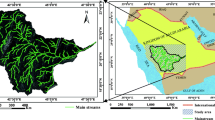Abstract
Floods are one of the most common natural hazards occurring all around the world. However, the knowledge of the origins of a food and its possible magnitude in a given region remains unclear yet. This lack of understanding is particularly acute in mountainous regions with large degrees in Sichuan Province, China, where runoff is seldom measured. The nature of streamflow in a region is related to the time and spatial distribution of rainfall quantity and watershed geomorphology. The geomorphologic characteristics are the channel network and surrounding landscape which transform the rainfall input into an output hydrograph at the outlet of the watershed. With the given geomorphologic properties of the watershed, theoretically the hydrological response function can be determined hydraulically without using any recorded data of past rainfall or runoff events. In this study, a kinematic-wave-based geomorphologic instantaneous unit hydrograph (KW-GIUH) model was adopted and verified to estimate runoff in ungauged areas. Two mountain watersheds, the Yingjing River watershed and Tianquan River watershed in Sichuan were selected as study sites. The geomorphologic factors of the two watersheds were obtained by using a digital elevation model (DEM) based on the topographic database obtained from the Shuttle Radar Topography Mission of US’s NASA. The tests of the model on the two watersheds were performed both at gauged and ungauged sites. Comparison between the simulated and observed hydrographs for a number of rainstorms at the gauged sites indicated the potential of the KW-GIUH model as a useful tool for runoff analysis in these regions. Moreover, to simulate possible concentrated rainstorms that could result in serious flooding in these areas, synthetic rainfall hyetographs were adopted as input to the KW-GIUH model to obtain the flow hydrographs at two ungauged sites for different return period conditions. Hydroeconomic analysis can be performed in the future to select the optimum design return period for determining the flood control work.
Similar content being viewed by others
References
Band, L.E. 1986. Topographic Partition of Watersheds with Digital Elevation Models. Water Resources Research 22(1): 15–24.
Chiang, S. Tachikawa, Y., Takara, K. 2007. Hydrological Model Performance Comparison through Uncertainty Recognition and Quantification. Hydrological Processes 21(9): 1179–1195.
CHOW, V. T., D. R. Maidment, and L. W. Mays 1988. Applied Hydrology, McGraw-Hill Book Co., New York.
Freeman, T.G. 1991. Calculating Catchment Area with Divergent Flow Based on a Regular Grid. Computer & Geosciences 17(3): 413–422.
Jenson, S.K., Domingue, J.O. 1988. Extracting Topographic Structure from Digital Elevation Data for Geographic Information System Analysis. Photogrammetric Engineering and Remote Sensing 54: 1593–1600.
Kumar, A. and Kumar, D. 2008. Predicting Direct Runoff from Hilly Watershed Using Geomorphology and Stream-order-Law Ratios: Case Study. Journal of Hydrologic Engrg., ASCE 13(7): 570–576.
LEE, K.T. 1998. Generating Design Hydrographs by DEM Assisted Geomorphic Runoff Simulation: a Case Study. Journal of American Water Resources Association 34(2): 375–384.
LEE, K. T. and YEN, B. C. 1997. Geomorphology and Kinematic-wave Based Hydrograph Derivation. Journal of Hydraulic Engrg., ASCE 123(1): 73–80.
LEE, K. T., CHANG, C.-H. 2005. Incorporating Subsurface-flow Mechanism into GEOmorphology-based IUH Modeling. Journal of Hydrology 311: 91–105.
LEE, K. T., CHEN, N.-C., CHUNG, Y.-R. 2008. Derivation of Variable IUH Corresponding to Time-varying Rainfall Intensity during Storms. Hydrological Sciences Journal 53(2): 323–327.
LEE, K. T., CHEN, N.-C., Gartsman, B. I. 2009. Impact of Stream Network Structure on the Transition Break of Peak Flows, Journal of Hydrology 367: 283–292.
Rodriguez-Iturbe, I., and Valdes, J. B. 1979. The Geomorphologic Structure of Hydrologic Response. Water Resour. Res 15(6): 1409–1420.
Shadeed, S., Shaheen, H., Jayyousi, A. 2007. GIS-based KWGIUH Hydrological Model of Semiarid Catchments: the Case of Faria Catchment, Palestine. The Arabian Journal for Science and Engineering 32(1C): 3–16.
Sherman, L. K. 1932 Stream-flow from Rainfall by the Unitgraph Method. Eng. News Rec. 108: 501–505.
Turcotte, R., Fortin, J.-P., Rousseau, A.N., Massicotte, S., Villeneuve, J.-P., 2001. Determination of the Drainage Structure of a Watershed Using a Digital Elevation Model and a Digital River and Lake Network. Journal of Hydrology 240: 225–242.
YEN, B. C. and LEE, K. T. 1997. Unit Hydrograph Derivation for Ungauged Watersheds by Stream Order Laws. Journal of Hydrologic Engrg., ASCE 2(1): 1–9.
Author information
Authors and Affiliations
Corresponding author
Rights and permissions
About this article
Cite this article
Cao, S., Lee, K.T., Ho, J. et al. Analysis of runoff in ungauged mountain watersheds in Sichuan, China using kinematic-wave-based GIUH model. J. Mt. Sci. 7, 157–166 (2010). https://doi.org/10.1007/s11629-010-0256-7
Received:
Accepted:
Published:
Issue Date:
DOI: https://doi.org/10.1007/s11629-010-0256-7




